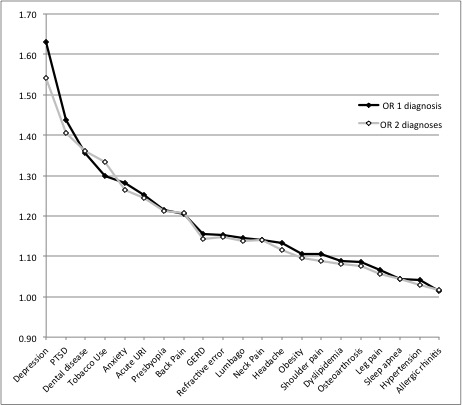Massive Text Minding Affirms Role of ACEs in a Veteran Population
Kenric Hammond
November 25, 2015
Kenric Hammond and VA investigators in Seattle and Salt Lake City performed large scale text mining analysis to identify occurrence of Adverse Childhood Experiences (ACEs) recorded in clinical notes. 250,000 VA-treated 1991 Gulf War veterans were identified along with their 44 million progress notes recorded between 2000 and 2011. Using natural language processing methods that combined search engine technology with supervised machine learning on extracted linguistic features, the investigators were able to infer veterans’ ACE exposure in each of 8 categories. This allowed assigning an ACE score, scaled from 0 to 4 or more distinct ACEs, to each veteran. Following the approach pioneered by Felitti et al. (Felitti, 1998), the relationship between adult diagnoses and ACE exposure was then analyzed using logistic regression to estimate change in disease probability per unit of ACE exposure.
Diagnoses were obtained from encounter records, and inferred lifetime and interval suicide attempts were extracted from clinical notes (Hammond, 2013). Logistic models adjusted for age, sex, and other relevant variables demonstrated strong associations between ACE score and suicide attempts and serious mental disorders (ORs 1.84 – 1.97) per unit of ACE score. Weaker associations were found with behaviorally mediated and somatic conditions (ORs 1.02 – 1.36) per unit of ACE exposure.
This work was supported by US Department of Veterans affairs HSR&D study HIR 10-001. The opinions expressed here are those of the authors and do not reflect those of the VA
Questions
1. Is ACE detection ready for clinical use?
- The ACE extraction methodology is capable of being scaled to encompass the entire VA-treated population, but accomplishing this is not trivial and would require considerable investment. Preliminary to doing so, it would make sense to first standardize ACE scores extracted from medical records against those elicited by interview or questionnaire for validation and standardization purposes. This work would require research support and IRB approval.
- Sufficient computer and human resources would be needed to process the current multi-terabyte collection of veteran documents. Secure leased “cloud” computing services would be worth considering for the large initial indexing task, while incremental indexing of new documents and search updates could be accomplished with modest additional computing resources.
- Implementation would require careful planning. Coordination with existing documentation, monitoring and reporting activities such as the VA’s National Suicide Prevention Center would be essential.
2. Should VA and DOD routinely record ACE? What about uses and misuses?
- Knowledge of ACE exposure could guide planning treatment and preventive services.
- Like any other indicator of disease probability, ACE history must be used for the patient’s benefit and not to stigmatize or restrict access to services or career opportunities.
3. What are the implications of knowing a population’s ACE profile?
- Will it result in program change?
- Will more attention be given to secondary prevention? (Screening for ACE; psychoeducational , peer support and preventive services)
- How will ACE surveillance articulate with procedures and goals of the VA’s National Suicide Prevention Center?
- Could knowledge of ACE exposure assist planning service needs?
4. Implications for future veterans’ epidemiologic study
- This research demonstrates both the feasibility of estimating, and the impact on health status, of exposure to Adverse Childhood Experiences (ACEs) among VA patients. Lifetime ACE score is an important unchanging indicator of risk for many common diseases. Combined with VA’s extensive databases, application of text mining will permit future epidemiologic studies to include ACE exposure. Veteran suicides, for instance, represent a subject area where ACE exposure information is highly relevant.
ACE categories: (exposure prior to age 18)
- Physical Abuse
- Sexual Abuse
- Emotional Abuse
- Neglect (emotional or physical)
- Parental separation or divorce
- Incarcerated family member
- Witnessing partner violence
- Substance abuse in a household member
- Mental illness in a household member
Odds ratio per unit ACE for commonly diagnosed conditions

Reference Article
Hammond, K. W., Ben-Ari, A. Y., Laundry, R. J., Boyko, E. J., & Samore, M. H. (2015). The Feasibility of Using Large-Scale Text Mining to Detect Adverse Childhood Experiences in a VA-Treated Population. Journal of Traumatic Stress, n/a-n/a. doi: 10.1002/jts.22058
Author Bio
Dr. Ken Hammond has practiced psychiatry and conducted health services research in the VA for more than 35 years. He resides in Washington State and is affiliated with the departments of Psychiatry and Behavioral Sciences and Biomedical Informatics and Medical Education at the University of Washington School of Medicine. His research interests address health care information systems, epidemiology, mental health and natural language processing.
References Cited:
Felitti, V. J., Anda, R. F., Nordenberg, D., Williamson, D. F., Spitz, A. M., Edwards, V., et al. (1998). Relationship of childhood abuse and household dysfunction to many of the leading causes of death in adults. The Adverse Childhood Experiences (ACE) Study. Am J Prev Med, 14(4), 245-258. doi: 10.1016/s0749-3797(98)00017-8.
Hammond, K. W., Laundry, R. J., O'Leary, T. M., & Jones, W. P. (2013). Use of Text Search to Effectively Identify Lifetime Prevalence of Suicide Attempts Among Veterans. Proceedings of the 46th Hawaii International Conference on Systems Sciences (HICSS-46), 46, 2676-2683. doi: 10.1109/hicss.2013.586.